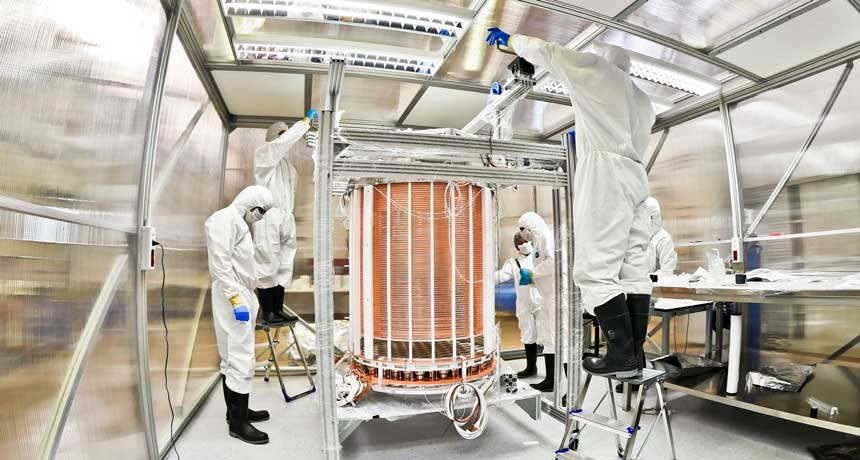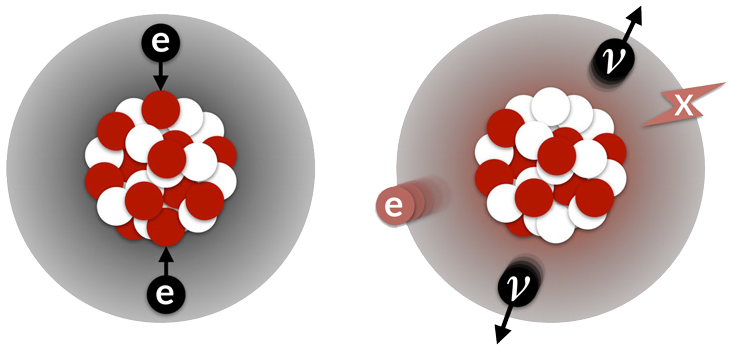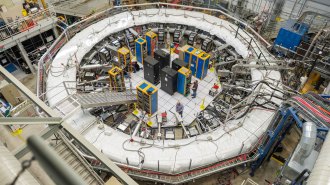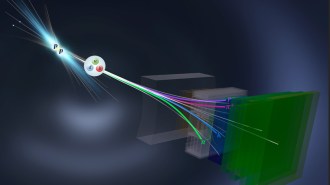This is the slowest radioactive decay ever spotted
It takes 1 trillion times the age of the universe for a xenon-124 sample to shrink by half

STRANGE DECAY In a first, scientists have directly detected an extremely rare type of radioactive decay called two-neutrino double electron capture.
XENON Collaboration
- More than 2 years ago
For the first time, researchers have directly observed an exotic type of radioactive decay called two-neutrino double electron capture.
The decay, seen in xenon-124 atoms, happens so sparingly that it would take 18 sextillion years (18 followed by 21 zeros) for a sample of xenon-124 to shrink by half, making the decay extremely difficult to detect. The long-anticipated observation of two-neutrino double electron capture, reported in the April 25 Nature, lays the groundwork for researchers to glimpse a yet unseen, even rarer version of this decay: neutrinoless double electron capture.
Observing that process would confirm that subatomic particles called neutrinos are their own antimatter particles, which could help resolve the mystery of why our universe is made almost entirely of matter, rather than antimatter (SN: 3/17/18, p. 14).
“It’s been quite the buzz within the community that this result is coming out,” says Lindley Winslow, a physicist at MIT not involved in the work.
Xenon-124 is an isotope, a form of an element having the same number of protons but a different number of neutrons (the number designates the total number of protons and neutrons in the nucleus). It’s one of the few radioactive isotopes that decays via two-neutrino double electron capture. But atoms undergo this decay so rarely that researchers needed to monitor a huge amount of xenon to stand a chance of seeing it.
Particle physicist Christian Wittweg of the University of Münster in Germany and colleagues searched for signatures of two-neutrino double electron capture with the XENON1T detector, a machine typically used to hunt for dark matter. The device, shielded from background radiation in the underground Gran Sasso National Laboratory in Italy, contains about three metric tons of xenon.
In two-neutrino double electron capture, an atomic nucleus snags two electrons from the surrounding electron shells, transforming two protons in the nucleus into neutrons and spitting out two neutrinos. Although the neutrinos themselves evade detection, the electron capture process emits X-rays and ejects other electrons from the atom that are detectable.
Decay time
In two-neutrino double electron capture, two electrons fall into an atom’s nucleus (illustrated at left), transforming two protons (red) into two neutrons (white). This decay emits two neutrinos (‘v’ at right), as well as electrons and X-rays.

From February 2017 to February 2018, XENON1T picked up the telltale emissions of two-neutrino double electron capture about 126 times. That pegs xenon-124’s half-life at about 18 sextillion years, which is the longest half-life ever directly measured in a radioactive substance — and about 1 trillion times longer than the age of the universe (SN: 3/2/19, p. 32).
“The fact that they’ve been able to measure these decays in xenon-124 is a great accomplishment,” says Javier Menéndez, a physicist at the University of Tokyo’s Center for Nuclear Study not involved in the work.
These results show the potential of dark matter detectors like XENON1T to spot neutrinoless double electron capture. It would follow a very similar decay process, but no neutrinos would escape the nucleus. Instead, gamma rays would exit the atom along with the X-rays and electrons seen in two-neutrino decay.
Theorists can also use the newly measured half-life to test how well theoretical models of the physics inside atomic nuclei describe this observation, Menéndez says. Those models of nuclear physics could inform the design of experiments that hunt for the neutrinoless version of the decay.
Neutrinoless double electron capture can occur only if neutrinos are their own antiparticles — that is, unlike normal particles that are paired up with antimatter counterparts, neutrinos wear both hats (SN: 8/19/17, p. 8). So if anyone were ever to observe this decay, that would confirm neutrinos’ dual nature.
Such a finding would have far broader implications than granting neutrinos special status among the universe’s hoi polloi of particles. One of the great mysteries of cosmology is why the universe is composed of matter, when matter and antimatter were supposedly produced in roughly equal amounts during the Big Bang. If neutrinos can act like both particles and antiparticles, then physicists suspect that the neutrinos played a key role in throwing the matter-antimatter balance in the early universe out of whack (SN: 7/6/02, p. 10).
The unsolved puzzle of matter-antimatter imbalance “is not the most embarrassing thing in particle physics, but it’s up there,” says Yury Kolomensky, a nuclear and particle physicist at the University of California, Berkeley not involved in the work. So confirming that neutrinos are indeed their own antiparticles to help resolve this conundrum “would be quite exciting.”







